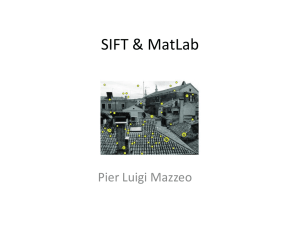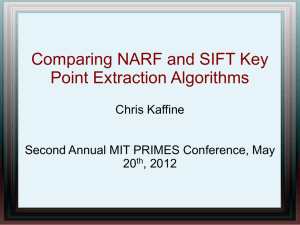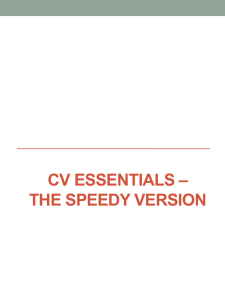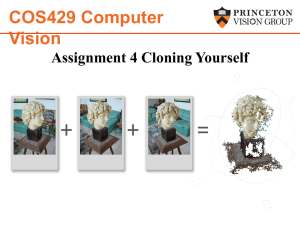Matlab Tutorial. Session 2. SIFT
advertisement
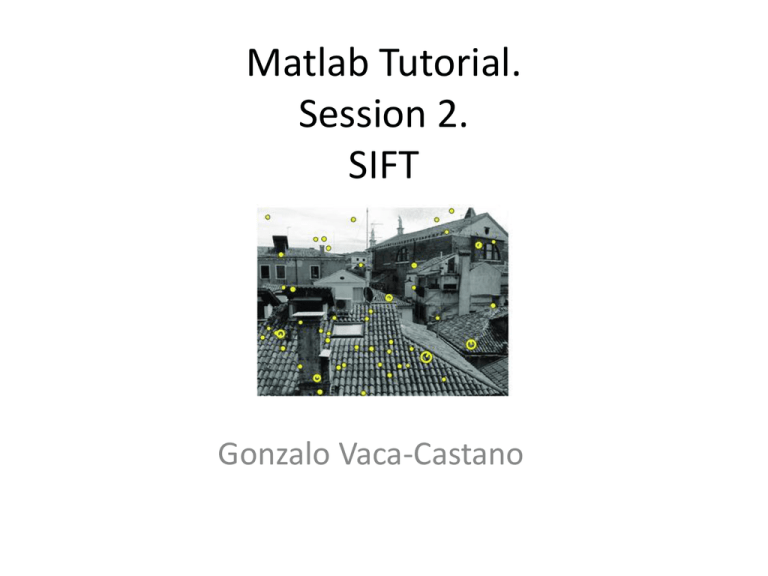
Matlab Tutorial.
Session 2.
SIFT
Gonzalo Vaca-Castano
Sift purpose
• Find and describe interest points invariants to:
– Scale
– Rotation
– Illumination
– Viewpoint
Do it Yourself
•
•
•
•
Constructing a scale space
LoG Approximation
Finding keypoints
Get rid of bad key points (A technique similar
to the Harris Corner Detector)
• Assigning an orientation to the keypoints
• Generate SIFT features
*http://www.aishack.in/2010/05/sift-scale-invariant-feature-transform/2/
Construction of a
scale space
SIFT takes scale spaces to the next level.
You take the original image, and generate
progressively blurred out images. Then,
you resize the original image to half size.
And you generate blurred out images
again. And you keep repeating.
The creator of SIFT suggests that 4 octaves
and 5 blur levels are ideal for the algorithm
Construction of a scale space (details)
• The first octave
•
If the original image is doubled in size and antialiased a bit (by blurring it) then the algorithm
produces more four times more keypoints. The more the keypoints, the better!
• Blurring
• Amount of Blurring
LoG approximation
Matlab Implementation !
% %%% Create first interval of the first octave %%%%%
init_image=impyramid(gauss_filter(image1,antialiassigma,4*antialiassigma),'expand');
gaussians(1)={gauss_filter(init_image,sigmavalue,4*sigmavalue)};
% %%% Generates all the blurred out images for each octave %%%%
% %%%
and the DoG images
%%%%
for i=1:num_octaves
sigma=sigmavalue; %reset the sigma value
for j=1:(num_intervals+2)
sigma=sigma*2^((j-1)/2); %Assign a sigma value acording to the scale
previmage=cell2mat(gaussians(j,i)); %Obtain the previous image
newimage=gauss_filter(previmage,sigma,4*sigma); %apply a new smoothing
dog=previmage-newimage; %calculate the difference of gaussians
%save the results
gaussians(j+1,i)={newimage};
dogs(j,i)={dog};
end
%Build the init image in the next level
if(i<num_octaves)
lowscale=cell2mat(gaussians(num_intervals+1,i));
upscale=impyramid(lowscale,'reduce');
gaussians(1,i+1)={upscale};
end
end
Finding keypoints
• a) Locate maxima/minima in DoG images
Matlab Implementation
for i=1:num_octaves
for j=2:(num_intervals+1)
% Obtain the matrices where to look for the extrema
level=cell2mat(dogs(j,i));
up=cell2mat(dogs(j+1,i));
down=cell2mat(dogs(j-1,i));
[sx,sy]=size(level);
%look for a local maxima
local_maxima=(level(2:sx-1,2:sy-1)>level(1:sx-2,1:sy-2)) & ( level(2:sx-1,2:sy-1) > level(1:sx-2,2:sy-1) ) & (level(2:sx-1,2:sy-1)>level(1:sx2,3:sy)) & (level(2:sx-1,2:sy-1)>level(2:sx-1,1:sy-2)) & (level(2:sx-1,2:sy-1)>level(2:sx-1,3:sy)) & (level(2:sx-1,2:sy-1)>level(3:sx,1:sy-2)) &
(level(2:sx-1,2:sy-1)>level(3:sx,2:sy-1)) & (level(2:sx-1,2:sy-1)>level(3:sx,3:sy)) ;
local_maxima=local_maxima & (level(2:sx-1,2:sy-1)>up(1:sx-2,1:sy-2)) & ( level(2:sx-1,2:sy-1) > up(1:sx-2,2:sy-1) ) & (level(2:sx-1,2:sy1)>up(1:sx-2,3:sy)) & (level(2:sx-1,2:sy-1)>up(2:sx-1,1:sy-2)) & (level(2:sx-1,2:sy-1)>up(2:sx-1,2:sy-1)) & (level(2:sx-1,2:sy-1)>up(2:sx1,3:sy)) & (level(2:sx-1,2:sy-1)>up(3:sx,1:sy-2)) & (level(2:sx-1,2:sy-1)>up(3:sx,2:sy-1)) & (level(2:sx-1,2:sy-1)>up(3:sx,3:sy)) ;
local_maxima=local_maxima & (level(2:sx-1,2:sy-1)>down(1:sx-2,1:sy-2)) & ( level(2:sx-1,2:sy-1) > down(1:sx-2,2:sy-1) ) & (level(2:sx1,2:sy-1)>down(1:sx-2,3:sy)) & (level(2:sx-1,2:sy-1)>down(2:sx-1,1:sy-2)) & (level(2:sx-1,2:sy-1)>down(2:sx-1,2:sy-1)) & (level(2:sx1,2:sy-1)>down(2:sx-1,3:sy)) & (level(2:sx-1,2:sy-1)>down(3:sx,1:sy-2)) & (level(2:sx-1,2:sy-1)>down(3:sx,2:sy-1)) & (level(2:sx-1,2:sy1)>down(3:sx,3:sy)) ;
%look for a local minima
local_minima=(level(2:sx-1,2:sy-1)>level(1:sx-2,1:sy-2)) & ( level(2:sx-1,2:sy-1) > level(1:sx-2,2:sy-1) ) & (level(2:sx-1,2:sy-1)>level(1:sx2,3:sy)) & (level(2:sx-1,2:sy-1)>level(2:sx-1,1:sy-2)) & (level(2:sx-1,2:sy-1)>level(2:sx-1,3:sy)) & (level(2:sx-1,2:sy-1)>level(3:sx,1:sy-2)) &
(level(2:sx-1,2:sy-1)>level(3:sx,2:sy-1)) & (level(2:sx-1,2:sy-1)>level(3:sx,3:sy)) ;
local_minima=local_minima & (level(2:sx-1,2:sy-1)>up(1:sx-2,1:sy-2)) & ( level(2:sx-1,2:sy-1) > up(1:sx-2,2:sy-1) ) & (level(2:sx-1,2:sy1)>up(1:sx-2,3:sy)) & (level(2:sx-1,2:sy-1)>up(2:sx-1,1:sy-2)) & (level(2:sx-1,2:sy-1)>up(2:sx-1,2:sy-1)) & (level(2:sx-1,2:sy-1)>up(2:sx1,3:sy)) & (level(2:sx-1,2:sy-1)>up(3:sx,1:sy-2)) & (level(2:sx-1,2:sy-1)>up(3:sx,2:sy-1)) & (level(2:sx-1,2:sy-1)>up(3:sx,3:sy)) ;
local_minima=local_minima & (level(2:sx-1,2:sy-1)>down(1:sx-2,1:sy-2)) & ( level(2:sx-1,2:sy-1) > down(1:sx-2,2:sy-1) ) & (level(2:sx1,2:sy-1)>down(1:sx-2,3:sy)) & (level(2:sx-1,2:sy-1)>down(2:sx-1,1:sy-2)) & (level(2:sx-1,2:sy-1)>down(2:sx-1,2:sy-1)) & (level(2:sx1,2:sy-1)>down(2:sx-1,3:sy)) & (level(2:sx-1,2:sy-1)>down(3:sx,1:sy-2)) & (level(2:sx-1,2:sy-1)>down(3:sx,2:sy-1)) & (level(2:sx-1,2:sy1)>down(3:sx,3:sy)) ;
extrema=local_maxima | local_minima;
end
end
Finding keypoints
• b) Find subpixel maxima/minima
Get rid of bad key points
• Removing low contrast features
If the magnitude of the intensity (i.e., without sign) at the current pixel in the DoG image (that is
being checked for minima/maxima) is less than a certain value, it is rejected
• Removing edges
Matlab Implementation
%indices of the extrema points
[x,y]=find(extrema);
numtimes=size(find(extrema));
for k=1:numtimes
x1=x(k);
y1=y(k);
if(abs(level(x1+1,y1+1))<contrast_threshold) %low contrast point are discarded
extrema(x1,y1)=0;
else %keep being extrema, check for edge
rx=x1+1;
ry=y1+1;
fxx= level(rx-1,ry)+level(rx+1,ry)-2*level(rx,ry); % double derivate in x direction
fyy= level(rx,ry-1)+level(rx,ry+1)-2*level(rx,ry); % double derivate in y direction
fxy= level(rx-1,ry-1)+level(rx+1,ry+1)-level(rx-1,ry+1)-level(rx+1,ry-1); %derivate inx and y direction
trace=fxx+fyy;
deter=fxx*fyy-fxy*fxy;
curvature=trace*trace/deter;
curv_threshold= ((r_curvature+1)^2)/r_curvature;
if(deter<0 || curvature>curv_threshold) %Reject edge points
extrema(x1,y1)=0;
end
end
end
Assigning an orientation to the
keypoints
Generate SIFT features
Generate SIFT features
• You take a 16×16 window of “in-between” pixels
around the keypoint. You split that window into sixteen
4×4 windows. From each 4×4 window you generate a
histogram of 8 bins. Each bin corresponding to 0-44
degrees, 45-89 degrees, etc. Gradient orientations
from the 4×4 are put into these bins. This is done for all
4×4 blocks. Finally, you normalize the 128 values you
get.
• To solve a few problems, you subtract the keypoint’s
orientation and also threshold the value of each
element of the feature vector to 0.2 (and normalize
again).
Testing the detector
• i=imread('groceries_gray.jpg');
• sift(i,3,5,1.1)
Vl_feat
• The VLFeat open source library implements
popular computer vision algorithms including
SIFT, MSER, k-means, hierarchical k-means,
agglomerative information bottleneck, and
quick shift. It is written in C for efficiency and
compatibility, with interfaces in MATLAB for
ease of use, and detailed documentation
throughout. It supports Windows, Mac OS X,
and Linux
Vl_feat
• Download vl_feat from http://www.vlfeat.org/
• run('VLFEATROOT/toolbox/vl_setup')
• Permanent setup
– To permanently add VLFeat to your MATLAB
environment, add this line to your startup.m file:
– run('VLFEATROOT/toolbox/vl_setup')
Extracting frames and descriptors
pfx = fullfile(vl_root,'data','a.jpg') ;
I = imread(pfx) ;
image(I) ;
I = single(rgb2gray(I)) ;
[f,d] = vl_sift(I) ;
perm = randperm(size(f,2)) ;
sel = perm(1:50) ;
h1 = vl_plotframe(f(:,sel)) ;
h2 = vl_plotframe(f(:,sel)) ;
set(h1,'color','k','linewidth',3) ;
set(h2,'color','y','linewidth',2) ;
h3 = vl_plotsiftdescriptor(d(:,sel),f(:,sel)) ;
set(h3,'color','g')
Basic Matching
[fa, da] = vl_sift(Ia) ;
[fb, db] = vl_sift(Ib) ;
[matches, scores] = vl_ubcmatch(da, db) ;
Visualization
•
•
•
•
•
•
•
•
•
•
m1= fa (1:2,matches(1,:));
m2=fb(1:2,matches(2,:));
m2(1,:)= m2(1,:)+640*ones(1,size(m2,2));
X=[m1(1,:);m2(1,:)];
Y=[m1(2,:);m2(2,:)];
imshow(c);
hold on;
line(X,Y)
vl_plotframe(aframe(:,matches(1,:)));
vl_plotframe(m2);
Custom frames
• The MATLAB command vl_sift (and the command line
utility) can bypass the detector and compute the
descriptor on custom frames using the Frames option.
• For instance, we can compute the descriptor of a SIFT
frame centered at position (100,100), of scale 10 and
orientation -pi/8 by
• fc = [100;100;10;-pi/8] ;
• [f,d] = vl_sift(I,'frames',fc) ;
• fc = [100;100;10;0] ;
• [f,d] = vl_sift(I,'frames',fc,'orientations') ;
